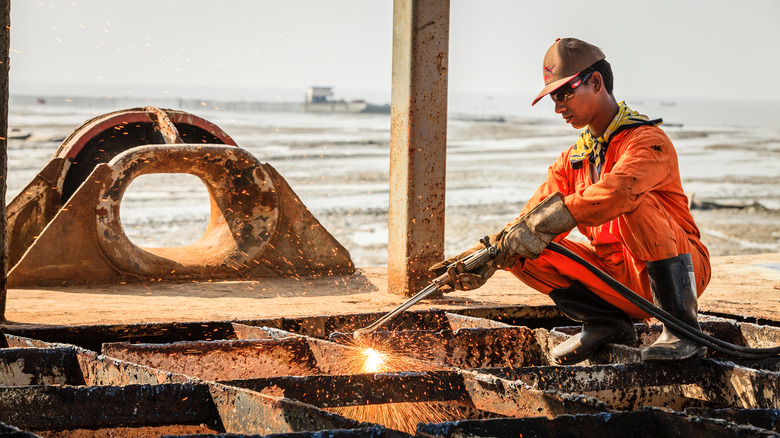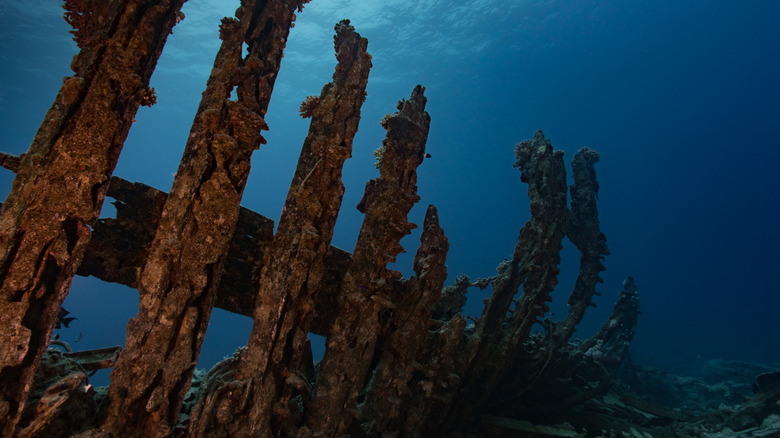The Unexpected Destination Cruise Ships Go To When They 'Die'
Halls once filled with laughter, pools with the sounds of glee, and theaters with their dazzling performers sit empty. Ships, once great mighty wanderers of the open ocean, are put to rest after their years of dedicated service. But unlike people, a sea vessel can't retire to a fun-filled private tropical island, so she is put to pasture a shell of her former self — in a cruise ship graveyard.
Generally, a cruise ship will remain in good working order for 30 years or so. In that time it will be updated while still functioning as a typical ship. By the time they're ready for decommissioning, some ships aren't even able to traverse on their own anymore and it isn't uncommon for other vessels, like tugboats, to haul these ships into a ship graveyard.
Even new cruise ships will someday be decommissioned. When they are, they'll likely be sent to one of the many dismantling or ship-breaking yards. These yards in Turkey and India will take the ships apart to reuse as much of the material as they can. The largest of these yards are Alang and Aliaga. "At both places, ships are run up onto the shore and gradually cut down," Peter Knego, journalist and ocean liner historian who runs Peter Knego's MidShipCinema on YouTube, told The Points Guy. This process differs from yard to yard, Knego added, though it usually involves cutting pieces away from the ship which is a difficult undertaking.
Breaking down the ships is dangerous work
There are several reasons you may not want to take a cruise, yet none are as unsettling as the process of ripping one apart. It is estimated that at least 800 ocean vessels are brought to shipbreaking yards every year, adding hulls to the graveyards' populations. Although there are myriad dangers when working with such massive carcasses and tools, there is one unexpected hazard for workers here: Asbestos.
Although the use of most asbestos was banned in 1989 in the United States, it was still being used in cruise ships until 2011. Because of this, ships are still being processed with yard workers being exposed to the dangerous material. Among the other materials scrapped from the ships, evidently, even the asbestos is sold off afterwards. Ingvild Jenssen, the executive director of Shipbreaking Platform which regulates ship recycling, told Chemistry World that there isn't enough infrastructure in countries like Bangladesh to properly dispose of the hazardous materials otherwise.
Hazards in taking these ships apart don't end at asbestos, though. Workers are also exposed to a range of other dangerous materials like polychlorinated biphenyls (PCBs), lead, and mercury, to name a few. Surprisingly, breaking down the ships is still environmentally and economically better than sinking them. Although Shipbreaking Platform acknowledges that only a few ships are broken down properly and safely.
A ship's potential post-breakdown life
Unlike a traditional graveyard, a shipbreaking yard may not be a ship's final destination. In fact, many broken-down ships go on to live fulfilling lives as artificial reefs. By sinking the husks of the ships, they can act as replacements for disappearing reefs to provide sea life a habitat. You can even visit sunken artificial reefs by diving, which happens to be one of the timeless things to do in Florida at the USCG Duane. Other ship husks may also be sunk but as part of military training exercises, per the Center for Land Use Interpretation.
A stop to a shipbreaking yard is crucial, though, to make a cruise ship into an artificial reef. Per the guidelines for artificial reefs in the Mediterranean and the Black Sea by the Food and Agriculture Organization of the United Nations, it is crucial to take ships apart first. This removes the potential pollutants to prevent harming the ocean, per the organization.
Plus, it's believed that cruise ships last longer as artificial reefs as opposed to other materials, which is ideal for the ecosystems that rely on reefs. Ultimately, it's not a bad gig to go from floating entertainment capital for humans to sunken entertainment capital for fish. It's like a ship circle of life.


